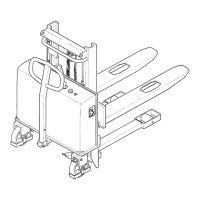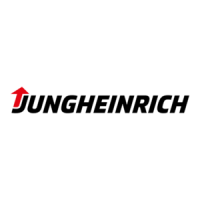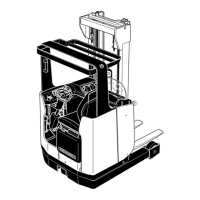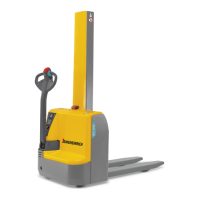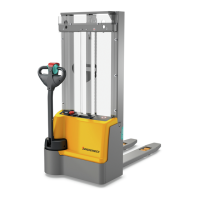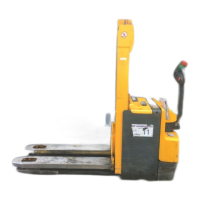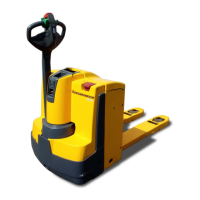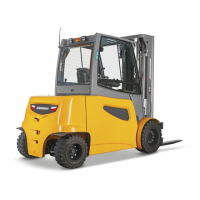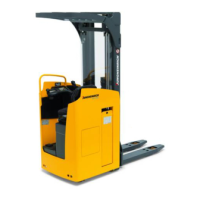0708.GB
F 4
4 Maintenance checklist
Maintenance Intervals
Standard = t WA BC
Cold store = k
Chassis/
Super-
structure:
1.1 Check all load bearing components for damage t
1.2 Check screw connections t
Wheels: 3.1 Check wheels for wear and damage t
3.2 Check suspension and attachment kt
Steering: 4.1 Check slack t
Brake
system:
5.1 Test operation and settings kt
5.2 Test recuperating function t
5.3 Check the brake lining wear t
Hydraulic
System:
6.1 Test operation kt
6.2 Check unions and connections for leaks and damage kt
6.3 Check hydraulic cylinder for leaks and damage and make
sure it is secure
kt
6.5 Replace hydraulic oil kt
6.6 Test operation of pressure relief valves kt
Electrical
system:
7.1 Test operation t
7.2 Make sure wire connections are secure and check for
damage
t
7.3 Check fuse ratings t
7.4 Test switches and trip cams and make sure they are
secure
t
7.5 Check contactors and relays; if necessary replace any
worn parts
t
7.6 Test all warning devices and safety switches. kt
Battery: 9.1 Check acid density, acid level and cell voltage kt
9.2 Check terminals are securely attached, and apply grease kt
9.3 Clean battery connections, make sure they are tight kt
9.4 Check battery cables for damage, replace if necessary. t
Mast: 10.1 Visually inspect rollers, slide pieces and stops kt
10.2 Check forks and fork carriage for wear and damage kt
10.3 Check mast attachment t
10.4 Check lift chains and guides for wear, adjust and lubricate. t
10.5 Check lateral slack and ensure mast sections are parallel t
10.6 Check protective mechanisms for damage and make sure
they are secure
kt
Lubri-
cation:
11.1 Lubricate truck in accordance with Lubrication Schedule. kt
General
measure-
ments:
12.1 Check electrical system for frame leakage t
12.2 Test lift and lowering speeds t
12.3 Test safety devices and cutouts t
Demon-
stration:
13.1 After carrying out maintenance, present the truck to the
supervisor.
kt
0708.GB
F 4
4 Maintenance checklist
Maintenance Intervals
Standard = t WA BC
Cold store = k
Chassis/
Super-
structure:
1.1 Check all load bearing components for damage t
1.2 Check screw connections t
Wheels: 3.1 Check wheels for wear and damage t
3.2 Check suspension and attachment kt
Steering: 4.1 Check slack t
Brake
system:
5.1 Test operation and settings kt
5.2 Test recuperating function t
5.3 Check the brake lining wear t
Hydraulic
System:
6.1 Test operation kt
6.2 Check unions and connections for leaks and damage kt
6.3 Check hydraulic cylinder for leaks and damage and make
sure it is secure
kt
6.5 Replace hydraulic oil kt
6.6 Test operation of pressure relief valves kt
Electrical
system:
7.1 Test operation t
7.2 Make sure wire connections are secure and check for
damage
t
7.3 Check fuse ratings t
7.4 Test switches and trip cams and make sure they are
secure
t
7.5 Check contactors and relays; if necessary replace any
worn parts
t
7.6 Test all warning devices and safety switches. kt
Battery: 9.1 Check acid density, acid level and cell voltage kt
9.2 Check terminals are securely attached, and apply grease kt
9.3 Clean battery connections, make sure they are tight kt
9.4 Check battery cables for damage, replace if necessary. t
Mast: 10.1 Visually inspect rollers, slide pieces and stops kt
10.2 Check forks and fork carriage for wear and damage kt
10.3 Check mast attachment t
10.4 Check lift chains and guides for wear, adjust and lubricate. t
10.5 Check lateral slack and ensure mast sections are parallel t
10.6 Check protective mechanisms for damage and make sure
they are secure
kt
Lubri-
cation:
11.1 Lubricate truck in accordance with Lubrication Schedule. kt
General
measure-
ments:
12.1 Check electrical system for frame leakage t
12.2 Test lift and lowering speeds t
12.3 Test safety devices and cutouts t
Demon-
stration:
13.1 After carrying out maintenance, present the truck to the
supervisor.
kt
